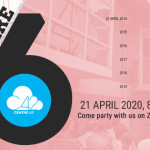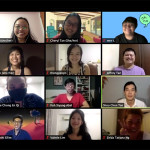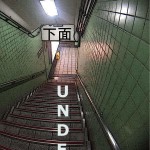Conceptualised by Jean Tay and Thong Pei Qin, Love Letters to 42 began as a repository of letters as tributes to Centre 42 for its 6 years of existence (also in conjunction with its 6th birthday) and each artist’s relationship to the space of 42 Waterloo street prior to mid-2020, at times even expanding to the larger Waterloo street precinct and the history of the space prior to Centre 42’s birth.
The letters reflected the sentiments of various artists, some being unhappy with the change, others welcoming it and embracing the ever-evolving nature of the space. Artists sent in letters in the form of text, images, music compositions and poetry. This repository was initially designed to be a static web page where users could click and view each letter. The concept soon morphed after bringing on a few more people into the project. Pei Qin approached Secretive Thing (Lemon x Koko) and Timothi Lim of The Doodle People and began to conceptualise an interactive version of this work.
This conceptualising took several months but soon began with some simple principles:
- We want to preserve the space as we remember it because we do not know how the space would change after the renovation.
- We want to allow users to interact with the different letters, in ways beyond “click and read”.
- We want some of the letters to be more than just text, and take on other artistic forms/ mediums, for a more visual engagement with the selected stories
- We wanted the users to be able to roam around the space and see Centre 42 as they remember it.
- For audiences both existing and new to Centre 42, they can also still see Centre 42 as a space that hosts performances live.
Space is connected to memory. As artists, arts housing spaces are closely connected to seasons of our creative journeys and careers. Centre 42 cultivated rigour in experimentation and critical discussion. Even though the space and usage of 42 Waterloo street has changed, the image of the iconic blue house and its cloud logo continues to represent these principles and serves as a reminder in our practice.
The nostalgia that comes with revisiting it digitally can inspire new developments and ways of art making, upon reflection of our time spent in the physical space – a revision of the premise and reasons to keep experimenting and a reminder to keep dialogue open. Being able to walk and experience the digital space in itself is a manifestation of this spirit.
This is a good venue or platform to start exploring making digital performances differently, outside of regular and co-opted platforms like Zoom, YouTube or Vimeo (which mostly co-ops from the film discipline). In a space that is familiar, and already has a following and community, we have been blessed to find supporters and fellow artists who are happy to go on this journey with us, even on a pro-bono basis out of goodwill.
Being on this project, and building this version of Centre 42 has revealed reasons why it should not be a neutral or unrecognised space. Despite being in its early stages, an unintentional product of this project has been the conversation held surrounding arts housing and art making, not just pertaining to Centre 42.
This Creation Residency is a period of exploration, testing, proto-typing and sharing learnings from the process of envisioning and making what the potential future of digital works can be like, through the creation of a virtual Centre 42.0.
ARTIST/PROJECT STATEMENT
Can a community continue to exist and grow without a physical space? This is the question we are interested in exploring.
After the NAC (National Arts Council) announced renovation works to 42 Waterloo street in 2020, Centre 42, as its artist community has come to recognise it as a physical space since 2014, is now gone. Although the NAC will still keep 42 Waterloo street as a shared arts space with the inclusion of ARH (Arts Resource Hub), the way the artist community gathers in it, and their relationship shared with Centre 42 in relation to the use of the space is perceived to be irrevocably changed. This narrative of spaces in transition and loss of arts spaces in Singapore is not a new one, and the change in the use of 42 Waterloo street prompted us to reflect and respond, in a bid to process this change, and understand how we would want to remember and re-imagine the space as we knew it.
Coupled with the measures and impact of the Covid-19 pandemic on performing arts, the circumstances have presented us with challenges to physically meet and make art like before. Taking advantage of interactive media, volumetric capture and mixed reality technology, we want to create a version of Centre 42 in a digital space to expand the limits of social connectivity, accessibility, interactivity and the making of performance.
Centre 42 @ 42 Waterloo Street has been pivotal to the ecology of the Singapore theatre scene. We have chosen to digitalise Centre 42 and to inquire if we can build art works and community in a digital space that has the familiar shape of a beloved arts space, and ultimately expand this digital world to a wider audience of art makers and creators.
DEVELOPMENT PROCESS
- Research
When we started out making this work we did not know where we would begin. It was quite a huge undertaking, especially for artists that were not familiar with digital game programming and video game design. Research into video games was a first step we undertook. We looked into video games that people enjoyed and that were similar to what we were intending to make.
Here are 3 main points that we sought to research through these games:
- Conceptualising
We wanted to create a world where users could interact with the space and also with each other. The concept of the world should ideally fuse all the elements that we felt could represent Centre 42’s space and community together into a single digital work that would preserve the identity of Centre 42 as we remember it, and yet also be a space where experimental digital works could also be tried and tested in an environment that was familiar to us.
With the collection of Love Letters to 42 as a starting point for content in this world, we wanted to place an installation where the different letters could be seen, read, heard and watched. A selection of letters are to be filmed, where visitors to this world can encounter the stories through the letter contributors and their history of this arts space. We envisioned the films as a blend of the digital and the analog world that would serve as a welcome to the virtual Centre 42.0.
- Filming and Editing
Out of the 42 letters, we curated 6 that we felt were suitable for the film medium, and collectively expressed the essence of what made Centre 42 the arts space that it was. The writers of the selected letters – Cheyenne Philips, Loo Zihan, Nessa Anwar, Karen Tan, Dominic Nah and Brown Voices collective – agreed to perform their writings as monologues for the camera. These letters were edited into scripts and rehearsed with the performers.
Filming was done at The Doodle People’s studio, and filmmaker Yusri ‘Shaggy’ Sapari came onboard to film and edit. Much of the filming was done against green screen. Additionally, we also used motion capture technology to capture the movements of the various actors to create a digital repository of their physical vocabularies.
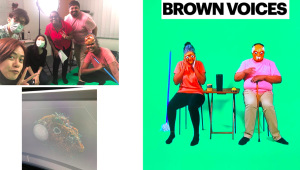
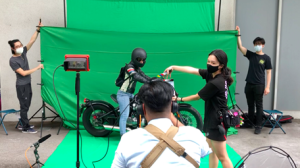
- World Building
For the world building, we began with architectural blueprints of the actual Centre 42 building (pre-2020). We passed them to architect and spatial designer Lim Wei Ling (of INDEX) who then 3D sketched the basic structures of the building, updated to how Centre 42’s blue house was at 2020. This skeletal 3D print was then used as the foundation for The Doodle People’s 3D modellers and graphics team to texture the model and place the building in a virtual environment. The team created the textures based off detailed photographic evidence and volumetric captures documented onsite at the physical premises before the blue house was renovated in late 2020.
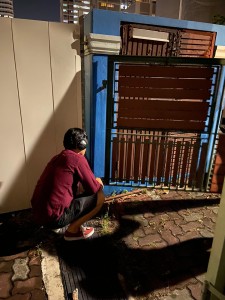
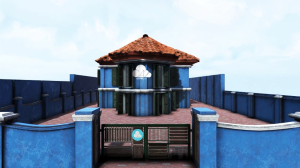
- UX/UI (User Experience, User Interface)
The Love Letters to 42 installation inside this virtual Centre 42 world needed to be simple for users to access and navigate:
- See 42 Letters
- Be able to open and view each letter, which comes in a text, image or film format. In no particular order (random).
- Collect Objects and add them to their Inventory for use during a multi-user event envisioned in future
- Add their own letter
Early references on our mood board for this installation included paper lanterns that fill up the night sky as glowing spots of fire. We selected the image as we felt that gently lit candlelight often represent respectful remembrance and was in line with the tone we wanted to set – that this collection of letters is a tribute to Centre 42. We were also interested in the movement the installation could take – blimps of light that could float around the User, and also appear as a recurring motif in one of the films we created with the content of a memorial.
Key questions we asked in attempting the designing of UX/UI:
- Do we want audiences/users to share new memories of the version of C42 they are existing in?
- Should we expand this prototype world into a multi-player experience further down the road, how will the installation exist as part of the user’s journey?
At the point of wrapping up the Residency, we are leaning towards expanding the collection of letters as a means to grow community and collective stories to continually bond people in a digital space, rather than just keeping the installation to just 42 letters which would then only serve as a “dead” archive. We envision an online platform featuring an evolving, relevant and current installation that audiences can continually interact with and revisit for new developments/ add-ons/ responses as replies from “pen-pals”, much like Kind Words or “comments/ reactions” functions of social media platforms. However, we would need to discuss the logistics and feasibility of maintaining such a space, with filter checks in place and the bandwidth of our administrative team in mind.
WORK-IN-PROGRESS SHARING
A gathering over Zoom was conducted on Sunday 28 May 2021, 3pm to share with invited artists about the progress of the Residency Project.
Through this initial sharing of our preliminary work, we have learned a lot about designing for digital environments. We are able to apply this knowledge of design and playing with green screens and motion capture technology into our other artistic endeavours where we deem fit in future. We see the various limitations that a screen, keyboard and mouse have but this challenge also forces us to think about how we can constantly keep audiences engaged in a story about a building that will no longer be the same anymore. Perhaps this story could be our starting point but the platform and associated memories could evolve in how the Users choose to view and interact with it. We are open to letting the agency of the audience take the lead eventually, and are also excited about the possibilities a virtual interactive platform will bring, in this marrying of live performances (and live administration) with designed gaming elements, during an envisioned live event hosted in this digital world in future.
As I was reflecting on this project I came to a few conclusions. This project is quite unique and different from how I would regularly think of making work. There are many limitations, either through the input (mouse and keyboard) that the user has. I had to constantly remind myself that the user was looking at a world through a screen. This screen view was different from all the other forms of work as the user would be in a place that they were comfortable in and could get easily distracted by anything at any time. It felt like we were leaving the work to the audience to figure out how the world works and how it can be used to make work or have fun. This really was not an easy task to constantly think of how to keep audiences interested or how to tell other makers to keep the pace of the work so that we don’t lose audiences. I’m sure that more people are now getting accustomed to viewing digital work, and hopefully they will be interested in this world that we are attempting to create as a means of showcasing “site specific” work in a digital environment.
~ Secretive Thing
NEXT PHASE
The journey ahead is not going to be an easy one. We have not been able to secure much funding and making digital work of this envisioned scale is expensive when we are starting from scratch. For now, we are committed to make Love Letters to 42 a workable prototype for audience/users to encounter and experience the world that is Centre 42 and the heartfelt tributes that many artists and art-makers have contributed to.
More details to come, as we work towards a September 2021 release of this next milestone.
Secretive Thing x Thong Pei Qin are the lead artists of this project, working closely in collaboration with Timothi Lim and The Doodle People.
Thong Pei Qin
Thong Pei Qin is a theatre director passionate about devising works of social relevance, featuring the original voices of Singaporeans. She holds two theatre degrees, from the University of Essex (M.A. Distinction, Theatre Directing), and the National University of Singapore (B.A. Honours, Theatre Studies). Selected recent directing credits comprise BOOM: A Zoom Read (Singapore Repertory Theatre 2020), Canned Rat Meat (The Theatre Practice 2020), SUPER MERMAID (Manipulate Festival 2019, Edinburgh), BITTEN: return to our roots (2018), When the Cold Wind Blows (Singapore Theatre Festival 2018), Step Outta Line (M1 Singapore Fringe Festival 2018), Maxx The Cat (The Finger Players 2017), State of Mind (Playground Entertainment 2016), and Between Consciousness (TheatreWorks 2016).
Pei Qin is currently a theatre lecturer at National Institute of Education (Visual and Performing Arts), National University of Singapore (Theatre Studies) and LASALLE (Performance).
Directing portfolio: (thongpeiqin.wix.com/livingtheatre) |FB Page: (www.facebook.com/thongpeiqin.director/)
Secretive Thing
Secretive Thing experiences are made by Lemon and Koko. Their experiences are usually kept secret because it incorporates the element of surprise to create a space for the audiences’ responses to be the catalysts for blah blah blah… But seriously, the less you know the better.
Secretive Thing’s most recently-made experience is Secretive Thing 215, presented at the M1 Singapore Fringe Festival 2020 from 9 – 19 January 2020 and was supported by Centre 42. The participatory performance was fully subscribed.
Timothi Lim
As a Creative Director, Timothi leads The Doodle People to develop AR effects and standalone apps to empower brand awareness, inspire clients, and support AR R&D for their business. As an individual, Timothi is an interactive media developer who seeks to connect generations through the union of physical and digital lifestyles. Timothi has developed interactive media works for a wide range of platforms from physical card games to the Hololens and Magic Leap headsets. His work has received awards and has been showcased at IndieCade, E3, and GDC. In his time as an interactive media developer, Timothi has worked with a wide range of firms including Grab Games, Sony Santa Monica, Riot Games, Marvel Entertainment, and Seagate Technologies.
Timothi recently completed a 3-session Online Workshop for arts practitioners “Performance Arts & Augmented Reality” that was presented by Centre 42 and commissioned by the National Arts Council.
www.timothiellim.com / www.linkedin.com/in/timothi-ellim
The Doodle People is a Singapore-based studio specialising in cutting-edge interactive and digital media. Founded in 2014, The Doodle People has been engaged by various organisations for their communications and branding needs. The studio’s strength is its ability to attract, captivate, engage, and empower their audiences, so applying their skills to performance arts was a natural progression. Find out more: www.thedoodlepeople.com
Jean Tay
Jean Tay graduated in 1997 with a double-degree in creative writing and economics from Brown University, USA. Plays produced include “Chinatown Crossings”, “The Shape of a Bird”, “It Won’t Be Too Long: The Cemetery – Dusk”, “Senang”, “Sisters”, “Boom”, “Everything but the Brain”, “Plunge”, “The Knot” and “Water from the Well”. Jean also wrote the books for the musicals “The Great Wall: One Woman’s Journey”, “The Admiral’s Odyssey”, “Man of Letters”, and a children’s musical “Pinocchio”. She has written over 20 plays and musicals, which have been performed in Singapore, the US, the UK, Italy and Indonesia. In 2000, her play “The Knot” was awarded 1st prize for Action Theatre’s 10-minute Play Competition. She has been nominated four times for Best Original Script for the Life! Theatre Awards, and won for “Everything But the Brain” in 2006.
Jean was attached to Singapore Repertory Theatre (SRT) as resident playwright from 2006-2009, and helmed SRT’s Young Company Writing Programme from 2012-2016. Her plays “Everything but the Brain” and “Boom” have been published by Epigram Books, and used as ‘O’ and ‘N’ Level literature texts for secondary school students. Jean is the founding Artistic Director of Saga Seed Theatre, set up in 2015 to bring Singaporean stories to the stage, and provide a platform to nurture local talent.
With Special Thanks to:
Lim Wei Ling, for providing the architectural drawing of the blue house as the foundation and starting point to build the virtual space.
Yusri “Shaggy” Sapari, as filmmaker and equipment support in the creation of the video stories.
Cheyenne Philips, Loo Zihan, Nessa Anwar, Karen Tan, Dominic Nah and Brown Voices collective, for lending their letters and selves in the filming of the stories.
All art-makers who had responded to the Love Letters to 42 Open Call and gave their contributions.
Love Letters was developed in residence at Centre 42’s Creation Residency from January 2021 to April 2021.
1 May 2020:
Love Letters to 42 began as an open call for letters to be collected and organised as an online repository of personal reflections and memories associated with Centre 42 and the iconic blue house on 42 Waterloo Street. Read more here.
28 March 2021:
A work-in-progress final sharing was conducted over Zoom to invited artists and art-makers for feedback and responses to the project concept and development.
Coming (in September 2021):
A workable prototype of Love Letters to 42 in the virtual Centre 42.
The Creation Residency supports artists to develop original text-based works for live and/or digital mediums. To learn more about the Residency, and to view the projects in residence now, click here.



